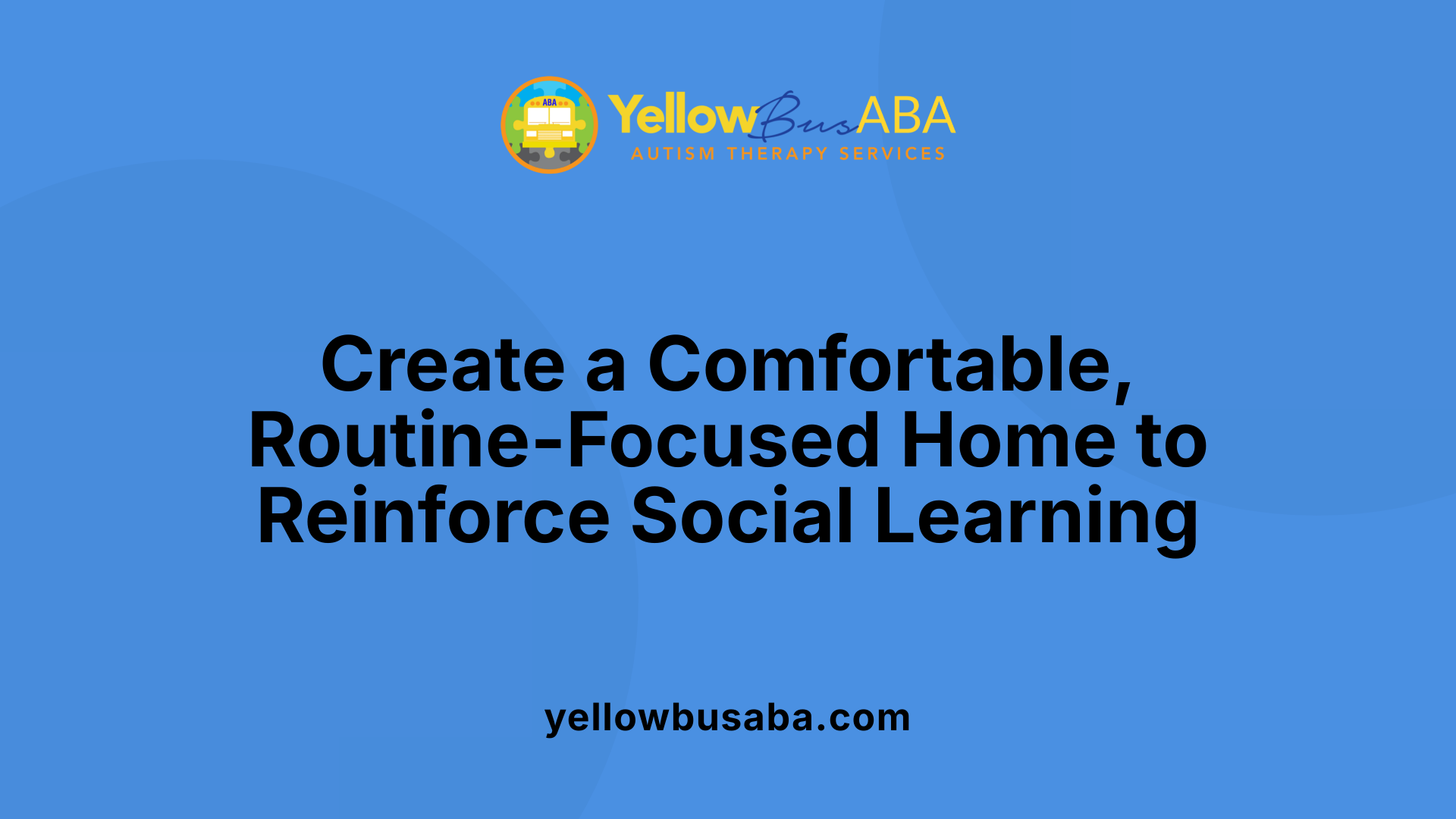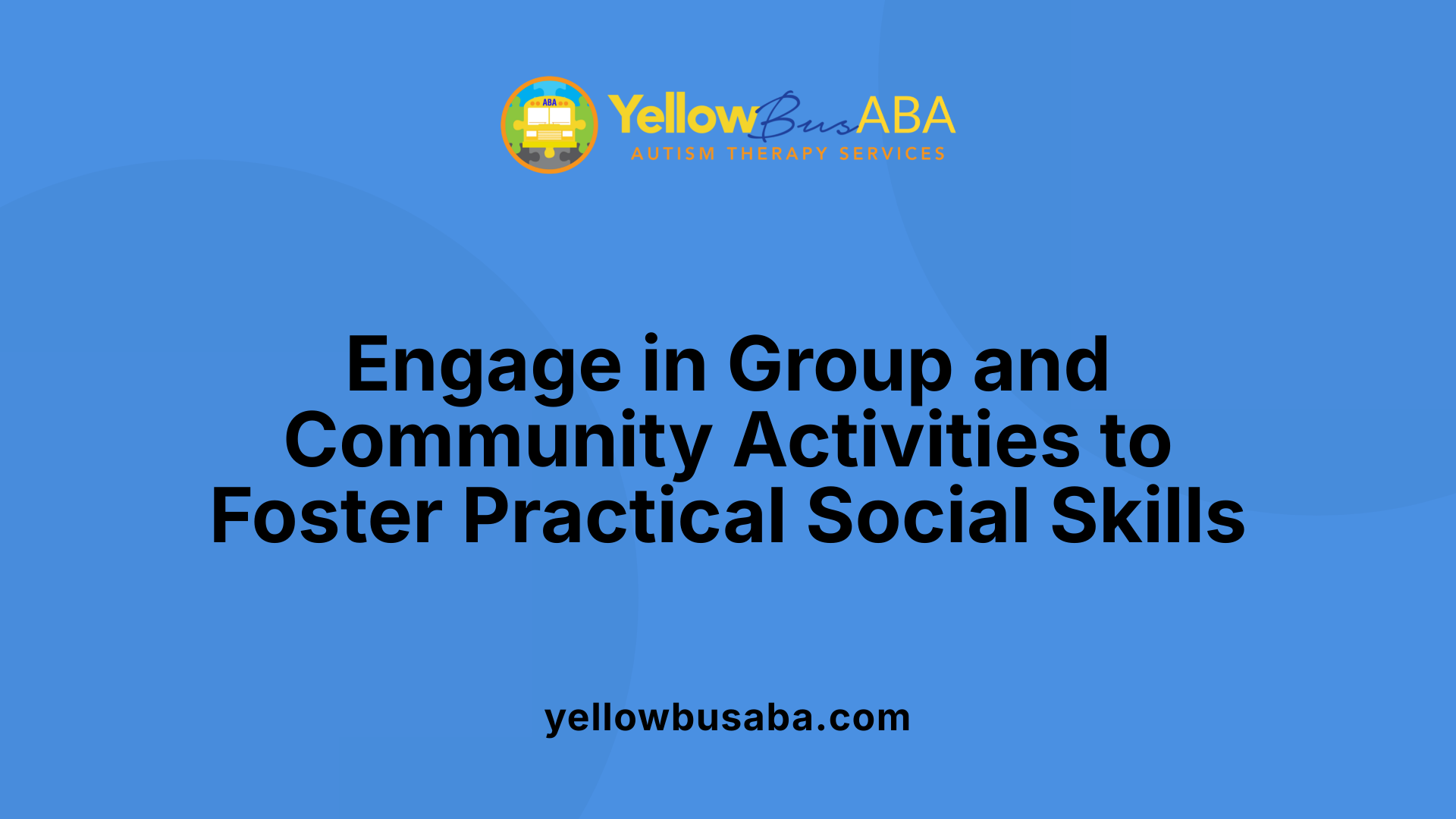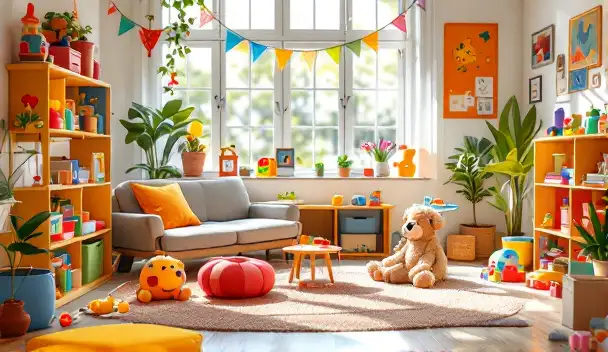How At-Home ABA Therapy Supports Social Skills Development
October 2, 2025
Empowering Social Growth at Home with ABA

Understanding the Power of In-Home ABA Therapy
At-home ABA therapy is a proven, evidence-based approach to fostering social skills in children with autism. By integrating tailored interventions within the comfort of the child's natural environment, this therapy promotes meaningful social engagement, enhances communication, and supports overall development. This article explores how in-home ABA therapy works, its benefits, the techniques utilized, and how parents and caregivers can actively participate to maximize outcomes.
The Foundations of ABA Therapy in Social Skills Development

What are the principles of ABA therapy, and how are they applied to social skills development?
Applied Behavior Analysis (ABA) therapy is based on scientific principles of learning and behavior modification. Core concepts include reinforcement, prompting, shaping, and data collection. These principles guide the development of customized programs tailored to each child's unique needs, especially when it comes to developing social skills.
ABA therapy breaks down complex social behaviors into simple, manageable steps. For example, initiating a greeting or understanding social cues can be taught sequentially, making skills more accessible for children. Techniques like modeling, role-playing, and visual supports, such as social stories and video modeling, provide clear, consistent examples of appropriate behavior.
Reinforcement is vital in encouraging social behaviors. When a child displays a desired social interaction—like making eye contact or sharing toys—immediate positive feedback, such as praise or tokens, increases the likelihood of repeat behavior. This positive reinforcement helps children associate social skills with positive outcomes.
ABA also emphasizes the importance of generalization—that is, applying learned skills across different settings and with various people. To accomplish this, therapists, parents, and teachers collaborate closely, creating opportunities for children to practice social behaviors in environments like home, school, and community outings.
Methods like social stories, which are personalized narratives that explain social situations in simple language, and natural environment teaching, help children understand the context and importance of social interactions. Video modeling allows children to observe and imitate appropriate social responses through engaging visual content.
Overall, ABA's individualized, evidence-based approach ensures that social skills are taught systematically, reinforced consistently, and generalized across many real-world contexts. This structured yet flexible framework supports children in becoming more socially competent and confident in their daily lives.
Creating a Supportive Environment at Home
 Practicing social skills at home offers numerous advantages for children with autism. The home setting is familiar and comfortable, reducing anxiety and making children more receptive to learning new behaviors. Tailored activities such as role-playing, social stories, and turn-taking games help children develop essential social skills like initiating conversations, maintaining eye contact, and sharing. These activities also build confidence and provide immediate opportunities for reinforcement, especially when paired with positive praise or rewards.
Practicing social skills at home offers numerous advantages for children with autism. The home setting is familiar and comfortable, reducing anxiety and making children more receptive to learning new behaviors. Tailored activities such as role-playing, social stories, and turn-taking games help children develop essential social skills like initiating conversations, maintaining eye contact, and sharing. These activities also build confidence and provide immediate opportunities for reinforcement, especially when paired with positive praise or rewards.
Eliminating transitions and maintaining routines are important strategies in a home environment. When transitions are minimized and routines are predictable, children experience less resistance and confusion, making it easier for them to engage in social skills activities. Using familiar routines also helps children connect new social behaviors with everyday contexts, leading to better generalization across different situations.
In addition, natural routines and reinforcers within the home, such as family activities, playtimes, or favorite toys, serve as motivating factors. These natural reinforcers reinforce positive behaviors and enhance learning outcomes. Integrating social skills practice into daily routines—like mealtimes, bedtime, or play—ensures consistency and maximizes the child's progress.
In summary, in-home ABA therapy creates an ideal environment for targeted social skills practice. It leverages familiar surroundings, consistent routines, and natural reinforcers to promote meaningful social interaction and help children generalize skills in real-world settings. Active involvement of parents and caregivers is essential, as their participation ensures reinforcement across different environments and fosters long-term social competence.
Structured Techniques for Teaching Social Skills

How are role-playing and social stories used as teaching tools in ABA therapy?
Role-playing and social stories are highly effective methods employed in ABA therapy to teach social skills. Role-playing allows children to practice social behaviors like greetings, sharing, and initiating conversations in a controlled environment. It helps children learn by doing, increasing confidence and competence.
Social stories are personalized narratives that describe specific social situations in simple language, often accompanied by pictures. These stories help children understand social norms, expectations, and appropriate responses, making complex social concepts easier to grasp.
Both tools provide a safe space for children to practice and reinforce social skills, bridging the gap between therapy and daily life.
What role do video modeling and visual supports play in ABA therapy?
Video modeling involves children watching videos that demonstrate appropriate social behaviors and interactions. This technique helps children learn through observation, making it especially useful for those who benefit from visual learning.
Visual supports include tools like checklists, emotion flashcards, and conversation flowcharts. These aids increase predictability and understanding, helping children interpret social cues and manage transitions more effectively.
Implementing visual supports and video modeling enhances comprehension, encourages imitation, and promotes the generalization of skills across different settings.
How do Discrete Trial Training and Natural Environment Teaching facilitate social skill acquisition?
Discrete Trial Training (DTT) is a structured approach where therapists break down social skills into small, manageable steps. These are taught sequentially, with clear instructions and immediate reinforcement for correct responses. DTT is especially effective for teaching specific behaviors like eye contact, turn-taking, or requesting.
Natural Environment Teaching (NET) involves teaching social skills in real-life settings, such as the home or community outings. It leverages naturally occurring situations to promote spontaneous use of skills, making learning more relevant and engaging.
Together, DTT provides structured learning of specific skills, while NET encourages generalization and the application of these skills in genuine social interactions. These techniques complement each other to create a comprehensive, effective social skills program in ABA therapy.
Role of Positive Reinforcement and Visual Aids
 In ABA therapy, especially when conducted at home, reinforcement strategies and visual aids are critical tools for developing social skills.
In ABA therapy, especially when conducted at home, reinforcement strategies and visual aids are critical tools for developing social skills.
Positive reinforcement involves praise, rewards, and token systems that encourage children to practice and maintain desired behaviors. When children successfully engage in social interactions, such as making eye contact or taking turns, they receive immediate positive feedback. This reinforcement strengthens the likelihood that these behaviors will occur again. Token systems are often used, where children earn tokens for specific actions, which they can exchange for preferred rewards, motivating ongoing social participation.
Alongside reinforcement, visual supports like communication checklists, social stories, and conversation flowcharts enhance understanding and predictability during social exchanges. Communication checklists help children track and remember social behaviors they are working on. Social stories—personalized narratives with simple language and pictures—assist children in understanding social norms and cues.
Flowcharts serve as visual guides that help children navigate conversations and social situations smoothly. These tools break down complex interactions into simple steps, making social participation less overwhelming.
Together, these reinforcement techniques and visual aids promote consistent practice of social skills in a structured, engaging way that fits into daily routines. They also provide clear expectations, which build confidence and independence.
| Tool Type | Description | Examples |
|---|---|---|
| Praise and Rewards | Verbal praise, tangible rewards, token systems | Stickers, extra playtime, earning tokens |
| Communication Checklists | Visual lists to track social behaviors | Greeting routines, eye contact checklist |
| Social Stories | Personalized stories with pictures and simple language | Navigating a social event, sharing toys |
| Conversation Flowcharts | Visual guides for initiating and maintaining conversations | Starting a chat, asking questions |
Research supports that integrating visual aids with reinforcement strategies effectively enhances social skill acquisition, fostering long-term independence and social competence in children with autism.
Building Social Skills through Group and Community Activities

How does group social skills training benefit children with autism?
Group social skills training offers children with autism valuable opportunities to practice interacting with peers in a supportive setting. Through structured activities like teamwork, sharing, and turn-taking, children learn essential social behaviors such as patience, respect, and cooperation. These group settings facilitate real-time social exchanges, helping children understand social cues and develop their communication skills.
During these sessions, children can also observe peers modeling appropriate behaviors, which can reinforce learning. Moreover, engaging in group activities reduces feelings of isolation and fosters a sense of belonging.
What role do community outings and peer playdates play in developing social skills?
Community outings, like trips to parks, libraries, or stores, allow children to apply their social skills in real-world environments. These outings encourage children to practice greeting others, navigating social norms, and managing unexpected situations with guidance. They also help build confidence and independence.
Peer playdates provide a safe space for children to develop friendships, share interests, and work on social skills such as sharing, taking turns, and communicating effectively. These interactions can be tailored to the child's developmental level, making social learning both fun and meaningful.
How can participation in virtual social groups support social development?
Virtual social groups create online environments where children with autism can connect with peers who share similar interests. These platforms often include video chats, group games, and themed activities, providing engaging ways to practice social skills.
Participating in virtual groups can be especially beneficial when in-person interactions are limited. They foster communication, emotional sharing, and friendship-building in a controlled, comfortable setting. Additionally, virtual groups often have facilitators who guide interactions, helping children learn to initiate conversations and interpret social cues.
| Activity Type | Focus Area | Benefits | Tools/Methods |
|---|---|---|---|
| Group social skills training | Peer interaction, social cue recognition | Builds teamwork, sharing, conversational skills | Role-playing, social stories, reinforcement |
| Community outings | Real-world social navigation | Promotes independence, confidence, social adaptation | Observation, guided practice |
| Peer playdates | Friendship development, sharing | Enhances communication, patience, empathy | Structured play, shared activities |
| Virtual social groups | Online communication, social engagement | Safe environment, convenient, practice initiation | Video chats, interactive activities |
When combining these activities with ABA strategies like positive reinforcement, children can improve their social skills in both structured and natural settings, leading to better social integration and overall well-being.
Fostering Generalization Across Settings
How does at-home ABA therapy support social skills development in children with autism?
In-home ABA therapy plays a vital role in helping children with autism develop important social skills within a familiar and comfortable environment. It provides a foundation for implementing personalized, evidence-based strategies such as role-playing, social stories, and turn-taking games. These activities teach children to initiate conversations, recognize emotions, and share with others.
Naturalistic approaches, including peer playdates and community outings, are integral to therapy. They allow children to practice skills in real-world settings, promoting the generalization of social behaviors beyond the therapy environment. Caregiver involvement and consistent reinforcement at home further solidify these skills, making them applicable in various social contexts.
ABA techniques such as social scripts, video modeling, and positive reinforcement motivate children and reinforce their progress. By combining structured interventions with everyday social experiences, in-home ABA therapy fosters meaningful interactions, enhances communication, and supports greater social inclusion for children with autism.
Why is collaboration among parents, teachers, and caregivers important?
Collaborating across different environments ensures consistency in applying social skills strategies. This teamwork helps children transfer skills learned during therapy to school, home, and community settings. When parents, teachers, and caregivers share insights and reinforce positive behaviors together, children experience a coherent and supportive learning experience.
How can practicing skills in varied environments benefit children?
Practicing social skills in diverse situations prepares children for real-life interactions. Whether in a park, a library, or a grocery store, children learn to adapt their behaviors, recognize social cues, and respond appropriately. These varied experiences help prevent the regression of skills and encourage flexible, confident social functioning.
What role do community outings and real-world experiences play?
Community outings serve as practical platforms for applying learned skills. They expose children to different social dynamics, opportunities for peer interaction, and real-world challenges. Such experiences not only build confidence but also promote independence and strengthen social connections.
| Aspect | Benefits | Additional Note |
|---|---|---|
| Parent & Caregiver Involvement | Reinforces skills consistently | Active participation at home supports generalization |
| Varied Environment Practice | Promotes adaptability | Practice in different settings ensures skills stick |
| Community Outings | Builds confidence and independence | Real-world experience enhances social competence |
| Social Skills Activities | Encourages spontaneous social interactions | Group activities foster peer engagement |
| Use of Technology and Apps | Provides engaging learning opportunities | Immediate feedback supports skill mastery |
Engaging in these varied opportunities ensures that children on the autism spectrum develop strong, adaptable social skills that thrive across all facets of daily life, ultimately improving their overall social competence and quality of life.
Role of Caregiver and Family Involvement
How can parents implement ABA strategies at home to enhance their child's social skills?
Parents play a vital role in reinforcing and generalizing social skills learned during ABA therapy. To do this effectively, they should establish a consistent and structured routine that provides predictability, helping children feel more secure and open to learning new behaviors.
Using positive reinforcement is essential. Praise, rewards, and fun activities motivate children to practice social interactions such as sharing, turn-taking, or making eye contact. Visual aids like pictures, schedules, or social stories can also facilitate understanding and make social expectations clearer for children.
Collaborating with trained professionals, including Behavior Analysts (BCBAs) and Registered Behavior Technicians (RBTs), offers parents tailored guidance suited to their child's unique needs. These experts can suggest specific activities or modify strategies to better fit the child's development.
Consistent practice across home, therapy, and community settings is critical. Family members should be involved to promote the child's confidence and social competence, fostering generalization of skills learned.
Engagement in social skills activities at home, paired with professional support, creates a strong foundation for children to develop meaningful social connections and improve their independence.
Training for parents and caregivers
Parents and caregivers undergo training to understand ABA principles and techniques. This training includes learning how to implement reinforcement strategies, manage behaviors positively, and use social stories or visual supports effectively. Regular updates and coaching from professionals ensure that strategies remain aligned with the child's progress.
Collaborative goal setting
Therapists, parents, and teachers work together to set realistic, measurable goals focused on enhancing social skills. These goals are tailored to the child's current abilities, with incremental steps towards more complex social behaviors such as initiating conversations or interpreting body language. Collaborative planning ensures consistency and encourages a shared commitment to the child's development.
Family involvement in ABA therapy
Research supports that family participation in ABA therapy significantly boosts success rates. Families involved in the process can provide natural reinforcers, practice skills in everyday situations, and support emotional regulation. Programs often include weekly meetings or training sessions to keep parents informed and engaged.
Search for more information
For more on how family involvement enhances ABA outcomes, search
Concluding Remarks: The Lasting Impact of In-Home ABA on Social Development
What are the benefits and effectiveness of at-home ABA therapy for improving social interactions?
In-home ABA therapy has proven to be highly effective in enhancing social skills for children with autism. Conducted within a familiar environment, it creates a comfortable setting that facilitates learning and generalization of new skills. Therapists tailor interventions to each child's specific needs, focusing on social behaviors such as initiating interactions, recognizing emotions, and non-verbal cues.
Through techniques like modeling, role-playing, and positive reinforcement, children learn to develop reciprocal communication, turn-taking, and emotional understanding. The structured approach includes setting personalized goals, breaking down complex behaviors into manageable steps, and reinforcing progress consistently.
Involving family members in therapy sessions fortifies social bonds and encourages the practice of learned behaviors in daily routines. This collaborative effort ensures that skills acquired during therapy extend beyond sessions, helping children navigate real-world social situations with greater confidence. Overall, in-home ABA therapy supports meaningful social development by fostering communication, independence, and positive interactions with others.
How do progress assessment and ongoing adaptation support social skill development?
Continuous assessment is fundamental to effective ABA therapy. Therapists regularly monitor each child's progress using detailed data collection, adjusting goals and strategies accordingly. This ongoing evaluation ensures that interventions remain aligned with the child's evolving needs and emerging social skills.
Adapting therapy plans based on assessment results helps target specific challenges—whether that involves improving eye contact, emotional recognition, or group interactions. As children demonstrate mastery of certain behaviors, therapists introduce more advanced social activities, such as group play or community outings, to promote skill generalization.
This dynamic process encourages steady growth and prevents stagnation. Regular reviews with parents and caregivers keep everyone informed and involved, which is crucial for reinforcing social skills across different environments. The flexibility of ongoing adaptation supports sustained improvements in social competence and helps children become more socially independent.
Why is early intervention and family support vital for social development?
Beginning ABA therapy early in a child's life significantly enhances social outcomes. Research shows that early intervention can improve IQ scores, language development, and social functioning, leading to better long-term success.
Addressing social challenges from a young age allows children to acquire foundational skills such as eye contact, joint attention, and emotional regulation at a critical developmental period. Early intervention also reduces the likelihood of more complex social deficits later on.
Family involvement is a cornerstone of successful social skill development. Educating parents and caregivers about effective strategies and encouraging consistent practice at home ensures that learned skills are reinforced daily. Family support creates a reliable environment for children to practice and generalize social behaviors, boosting their confidence and social interactions.
In summary, early intervention combined with active family participation provides a strong foundation for lifelong social success, enabling children to build meaningful relationships and participate actively in their communities.
The Transformative Role of Home-Based ABA in Social Skills
In-home ABA therapy emerges as a cornerstone in the development of social skills for children with autism. Its individualized, naturalistic approach facilitates consistent learning, promotes generalization across environments, and involves families actively in the therapeutic process. Through proven techniques, positive reinforcement, and collaborative efforts, in-home ABA helps children build essential social competencies that lead to greater independence, confidence, and social inclusion. Early intervention and dedicated parental involvement further amplify these benefits, making in-home ABA a powerful tool to enhance quality of life and foster lasting social growth.
References
- Developing Social Skills Through ABA Therapy for Autism
- ABA Therapy at Home | Social Skills Activities for Children ...
- In-home ABA therapy: Beginner's guide for parents
- Applied Behavior Analysis (ABA)
- How ABA Therapy Enhance Social Skills in Kids
- How ABA Therapy Helps With Social Skills
- What are the benefits of in-home ABA therapy?






.jpg)